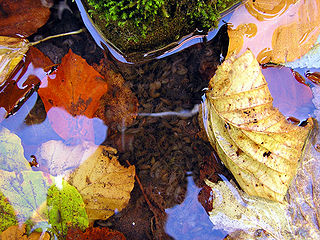
Homarus is a genus of lobsters, which include the common and commercially significant species Homarus americanus and Homarus gammarus. The Cape lobster, which was formerly in this genus as H. capensis, was moved in 1995 to the new genus Homarinus.

Homarus gammarus, known as the European lobster or common lobster, is a species of clawed lobster from the eastern Atlantic Ocean, Mediterranean Sea and parts of the Black Sea. It is closely related to the American lobster, H. americanus. It may grow to a length of 60 cm (24 in) and a mass of 6 kilograms (13 lb), and bears a conspicuous pair of claws. In life the lobsters are blue, only becoming "lobster red" on cooking. Mating occurs in the summer, producing eggs which are carried by the females for up to a year before hatching into planktonic larvae. Homarus gammarus is a highly esteemed food, and is widely caught using lobster pots, mostly around the British Isles.

The Cape lobster, Homarinus capensis, is a species of small lobster that lives off the coast of South Africa, from Dassen Island to Haga Haga. Only a few dozen specimens are known, mostly regurgitated by reef-dwelling fish. It lives in rocky reefs, and is thought to lay large eggs that have a short larval phase, or that hatch directly as a juvenile. The species grows to a total length of 10 cm (3.9 in), and resembles a small European or American lobster; it was previously included in the same genus, Homarus, although it is not very closely related to those species, and is now considered to form a separate, monotypic genus – Homarinus. Its closest relatives are the genera Thymops and Thymopides.
Gammarus setosus is a gammarid amphipod that inhabits the northern coasts of both the Atlantic and Pacific oceans. Typically, this crustacean is found in the benthic sub-tidal or low inter-tidal regions. Gammarus setosus reproduces once a year in the autumn.

Anaspididae is a family of freshwater crustacean that is endemic to Tasmania, Australia. The family contains 3 genera and 5 species. This group of crustaceans are considered living fossils. They are commonly and collectively known as the Tasmanian anaspid crustaceans. Anaspidids have stalked eyes, long antennae and antennules, and a slender body with no carapace. The two species of Allanaspides and the single species of Paranaspides are all listed as vulnerable on the IUCN Red List.

Gammarus pulex is a species of amphipod crustacean found in fresh water across much of Europe. It is a greyish animal, growing to 21 mm (0.83 in) long.
The phantom cave snail or phantom cavesnail is a species of very small freshwater snail with an operculum, an aquatic gastropod in the family Hydrobiidae.

Branchinecta is a genus of crustacean in family Branchinectidae. It includes around 50 species, found on all continents except Africa and Australia. Branchinecta gigas, the giant fairy shrimp, is the largest species in the order, with a length of up to 10 centimetres (4 in), and Branchinecta brushi lives at the highest altitude of any crustacean, at 5,930 metres (19,460 ft), a record it shares with the copepod Boeckella palustris. A new genus, Archaebranchinecta was established in 2011 for two species previously placed in Branchinecta.
Gammarus acherondytes, the Illinois cave amphipod, is a species of crustacean in the family Gammaridae. The crustacean is endemic to the Illinois Sinkhole Plain of Monroe County and St. Clair County, in southwestern Illinois, including Illinois Caverns State Natural Area.

Gammarus is an amphipod crustacean genus in the family Gammaridae. It contains more than 200 described species, making it one of the most species-rich genera of crustaceans. Different species have different optimal conditions, particularly in terms of salinity, and different tolerances; Gammarus pulex, for instance, is a purely freshwater species, while Gammarus locusta is estuarine, only living where the salinity is greater than 25‰.

Gammarus desperatus is a species of amphipod crustacean in the family Gammaridae.
Gammarus hyalelloides is a species of amphipod crustacean in the family Gammaridae. It is endemic to four springs in Jeff Davis County and Reeves County, Texas, and is listed as a vulnerable species on the IUCN Red List.

Gammarus pecos, commonly known as the Pecos amphipod, is a species of crustacean in family Gammaridae. It is endemic to Pecos County, Texas in the United States, where it is known from only two locations: Diamond Y Spring and Leon Creek.
Mexistenasellus is a genus of isopod crustaceans in the family Stenasellidae. It contains 6 species, of which 4 are listed as endangered or vulnerable on the IUCN Red List.
Sphaerolana is a genus of isopod crustaceans in the family Cirolanidae, all of which are endemic to Mexico. The genus Sphaerolana contains the following species: All three species are on the IUCN Red List as either vulnerable species (VU) or endangered species (EN).

Stygobromus is a genus of amphipod crustaceans that live in subterranean habitats. As well as a large number of species in North America, a smaller number of species are also known from Eurasia. Most of the North American species live in areas which were not covered by the Laurentide Ice Sheet, although a few species seem to have survived under the ice. A number of species are on the IUCN Red List as endangered species (EN) or vulnerable species (VU); all the listed species are endemic to the United States. One species, S. lucifugus, is extinct. Stygobromus includes the following species:

Thermosphaeroma is a genus of crustacean in family Sphaeromatidae. They occur exclusively in hot springs of southwestern United States and central Mexico.
Gammarus baysali is a cave-dwelling species of freshwater amphipod crustacean, found in Turkey. The species belongs to the broader Gammarus pulex group and was scientifically described in 2013 from Cumayanı Cave, Zonguldak Province.
Gammarus hoonsooi is a species in the genus Gammarus in the family Gammaridae, in the order Gammaridea - which belongs to the taxon amphipoda.










